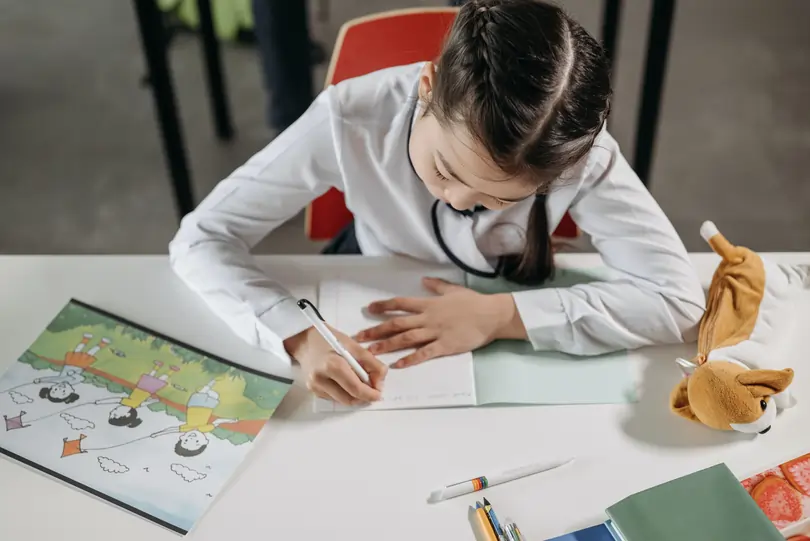Synthesis & Transformation
Synthesis & Transformation refers to the combining of sentences using conjunctions. Two sentences will be given, which you will be required to link together with conjunctions. Before we try that, let's first understand what conjunctions are.
What are Conjunctions?
Conjunctions are words that link words, phrases and clauses together. For example: although, for, as, because, so, yet, while, along, and also phrases like ‘as well as’.
Examples Of Conjunctions:
Question 1:
Father did not agree so he shook his head.
__________ in __________.
Answer:
Father shook his head in disagreement.
Question 2:
What do FANBOYS stand for?
- for, and, nor, but, or, yet, so
- few, and, neither, otherwise, yet, so
Answer:
FANBOYS is an acronym which stands for the following conjunctions:
For, And, Nor, But, Or, Yet, So
In option (2), some of them, like "few" and "otherwise", are not conjunctions at all.
Examples of Synthesis & Transformation:
Question 1:
Jenny is tired. Chris is tired.
Is there a mistake in the sentence below?
Both Jenny and Chris is tired.
- Yes
- No
Answer:
Yes. Where "both" is used, it refers to two separate characters or two separate subjects (Jenny and Chris). With two separate subjects, you usually use a singular verb. However, as we have combined them together here using "both", they are no longer singular. Instead, they are plural, and we need to pair them with a plural verb. As such, the correct sentence will be:
Both Jenny and Chris are tired.
Question 2:
The coach is travelling to Spain. His team is travelling to Spain.
__________ along with __________.
- The coach, along with his team, are travelling to Spain.
- The coach, along with his team, is travelling to Spain.
Which one is correct?
Answer:
The correct answer to this question is Option 2, i.e. "The coach, along with his team, is travelling to Spain".
The grammar rule behind this is that expressions of addition, or any additional information like "along with his team" or "as well as" will be disregarded In this case, we will be left with "the coach", which is singular. Therefore, we have to use the singular verb "is". In questions like these, disregard the extra information and do not factor them in as a subject.
Question 3:
The pair of koalas is climbing the tree. Their cubs are climbing the tree.
__________ as well as __________.
Answer:
The correct answer to this question is:
The pair of koalas, as well as their cubs, is climbing the tree.
Here, it would seem that "are" would be the correct verb to use because of the plural subject “cubs”. But as we have learned earlier not to factor in the additional information, “cubs”, is not the subject. Instead, ”koalas” is the subject here, which appears to be plural. However, ”koalas” have been combined into a single pair, which is a collective noun. As it is one pair, it will be considered singular. Thus, the correct verb to be used here will be "is".
Question 4:
The goods will be delivered if you pay up.
Unless __________.
- Unless you pay up, the goods will be delivered
- Unless you pay up, the goods will not be delivered
Answer:
The correct answer to this question is Option (2). The main difference is between “will be” and “will not be”: the first one is positive, while the latter one is negative. The meaning of unless is "except if", or is used to say what will or will not happen if something else does not happen or is not true.
“Unless” here means if you don't pay, the goods will not be delivered. This is as opposed to Option (1), where it would mean if you do not pay up, the goods will be delivered, which is incorrect as you are not providing the money for the goods.
Test Your Concepts
Answer the following questions based on the concepts we’ve covered in this article. If you get stuck, revisit the relevant section to revise the concepts.
Question 1:
Which conjunction is the most suitable for surprising or contrasting statements? For example:
He is friendly. He has very few friends.
- Yet
- So
- Because
Question 2:
I was exhausted __________ I finished all my work.
- So
- Nor
- And
- Yet
Question 3:
He was homeless __________ he had lost his job, house and savings.
- So
- Nor
- For
- Yet
Question 4:
The man’s dog passed away. He is devastated.
__________ whose __________.
Question 5:
If I do not get 95 marks for English, I will be grounded.
Unless __________.
Test Yourself
Which conjunction is the most suitable for the statement below?
He is friendly. He has very few friends.
Yet is a conjuction of contrast. "Because" and "So" provides reasons for the contrast, which is not mentioned in the statement.
Which conjunction is the most suitable for the statement below?
I was exhausted. __________ I finished all my work.
This is a contrasting statement. "Yet" is used to show contrast.
Which conjunction is the most suitable for the statement below?
He was homeless __________ he had lost his job, house and savings.
"Had lost" is a past perfect tense that shows the order of action. Since he was homeless because he had lost his job, house and savings, "For" is used as a conjunction of reason.


 SG
SG  VN
VN 










